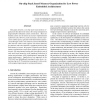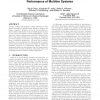190 search results - page 20 / 38 » Using non-volatile memory to save energy in servers |
DATE
2003
IEEE
14 years 19 days ago
2003
IEEE
This paper presents a on-chip stack based memory organization that effectively reduces the energy dissipation in programmable embedded system architectures. Most embedded systems ...
ISLPED
2004
ACM
14 years 23 days ago
2004
ACM
Traditionally, dynamic voltage scaling (DVS) techniques have focused on minimizing the processorenergy consumption as opposed to the entire system energy consumption. The slowdown...
GRID
2005
Springer
14 years 25 days ago
2005
Springer
Abstract— Differential Deserialization (DDS) is a SOAP optimization technique wherein servers save checkpoints and parser states associated with portions of previously received m...
SIGMETRICS
2010
ACM
13 years 5 months ago
2010
ACM
Dynamic voltage and frequency scaling (DVFS) is a wellknown technique for gaining energy savings on desktop and laptop computers. However, its use in server settings requires care...
CODES
2005
IEEE
13 years 9 months ago
2005
IEEE
Caches may consume half of a microprocessor’s total power and cache misses incur accessing off-chip memory, which is both time consuming and energy costly. Therefore, minimizing...


